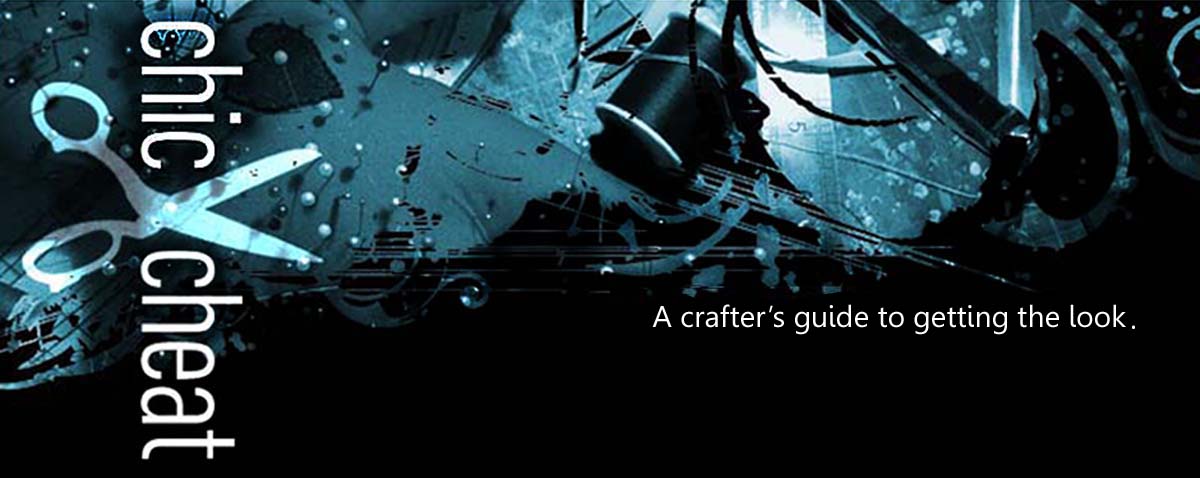Total Cost
About £8…Save it!
… Which, compared to the £250 price tag of the original, pales into insignificance at less than a thirtieth of the price, or a saving of about £242.You Will Need
1.5m of black grosgrain ribbon. Hobbycraft do one which is just under an inch and a half wide, priced at 75p per metre.Half a metre of sheer black ribbon, also available at Hobbycraft at 39p a metre.
Picture hooks to mimic the hinges on the original ( I haven’t been able to find appropriate hinges of the right size, but the look that the picture hooks method gives off is pretty authentic) priced at £1.32 a packet at Wickes. Also some wire to bind them together. I used copper wire I found at home.
Chunky golden chain, something my tongue falters while I say, as it’s not the sort of item you’d typically associate with fine taste. Furthermore, the chain I used for this entry came in the form of a 3-chain bracelet from Primark and cost £1. Just think of the black ribbon textures and gems which make this exercise all worthwhile!
A selection of round, diamond-shaped and teardrop-shaped rhinestones in white, green, yellow, red, purple and black if you can find one. I picked mine up from a haberdasher’s in Birmingham’s St Martin’s market and the total cost came to £1.11
Black leather fake leather will do.
2 gold eyelet holes they cost £2.99 a packet at Hobbycraft
2 pairs of long-nosed pliers
Needle and thread
Pritt stick or equivalent
Ruler, fabric scissors and metallic gel pen
Sewing machine with a leather needle the latter is available at all good haberdashers.
Hammer and scrap piece of wood or - if you have some -eyelet pliers
Something to punch a hole through leather - I used a scalpel, but if you have a leather hole puncher, so much the better.
Get your Lim beau rocks on…
Look at the way the ribbon on the original is folded. It’s concertina-folded, like a fan, in the way that it curves around.Take your grosgrain ribbon and fold it concertina-style, but in such a way that the pleats overlap, causing the pleats to be about 1″ deep, but for them to appear to be about 1cm deep on the surface. Notice, on the original, that the pleats are also done at an angle to make it curve round, so you need to mimic that with the grosgrain in order to get the same effect. Pin each pleat in place after you’ve folded it. You should use up the entire ribbon to get the right length.
When the pleats are pinned in place, secure them by machine-stitching along the top.
When you pick your grosgrain ribbon up, you will probably find it curves round in a spiral. Don’t worry about this, as you can secure it in its original curves shape by stitching it by hand along the bottom. Just run your needle and thread through the pleats, keeping it beneath the surface so that it can’t be seen.
Cut four of each of the following pieces out of leather:
Fold back the flaps and use your glue stick to hold them in place. Using your sewing machine and leather needle, sew the hexagonal pieces one on top of the other so that no raw edges are showing.
Punch a hole in the narrow top end of each of the two new hexagonal pieces and insert the eyelet hole. The eyelets I suggested come with instructions as to how to use your hammer or eyelet pliers. Ensure that you follow instructions carefully and take care not to cause damage with your hammer, if you’re using one.
Cut your sheer black ribbon in half and thread each piece through the eyelet holes. Secure them by tying them in a knot around the leather piece.
With the flaps of your rectangular leather pieces glued back, sandwich your black grosgrain ribbon between each set of two, pin them together and sew them in place.
Time to create your “hinges” with your picture hooks. Use your pliers to bend the hook all the way back so that it forms an enclosed loop shape. Repeat this process with three more hooks.
Place each hook in the middle of the top of your rectangular leather pieces and the bottom of your hexagonal pieces, on the opposite side to where the eyelet hole is. Stitch them in place. You may need to stitch from a few different angles in order to secure your hooks properly.
Feed a small piece of wire through the enclosed hooks and twist them with your pliers to secure them in place.
Detach all three pieces of chain from your Primark bracelet using your pliers, you should be able to prise open the small connecting wire loop fairly easily.
Attach two full chains onto each other using your pliers and one of the connecting loops. Repeat this with a third chain. You will probably find it is too long to fit onto your necklace, so you can trim it down by using both sets of pliers to pull the strong chain links apart.
Stitch the chain, link-by-link along the top of your necklace.
Finally, stitch your gems on, using the original as inspiration as to where to stitch them.





























































